
U.S. First Army
Encyclopedia
The First United States Army is a field army
of the United States Army
. It now serves a mobilization, readiness and training command.
(AEF) in the latter stages of World War I
it was the first of three field armies established under the AEF. Serving in its ranks were many figures who later played important roles in World War II
. First Army was inactivated in April 1919.
, Army Chief of Staff, General Douglas MacArthur
directed the establishment of four field armies that each commanded three corps area
s that were geographically located. The field armies were established to provide organizational structure for large military organizations that might be mobilized in time of national need.
First Army was located in the northeast United States and was activated on 11 September 1933 at Fort Jay
, Governors Island
, New York. Initially activated as a paper army, it was commanded by General Dennis E. Nolan
. Until 1942, First Army's commander was always the senior commander of one of its three corps area
s. The First Corps Area was headquartered in Boston, Massachusetts, Second Corps Area was headquartered at Fort Jay
, Governors Island
in New York, New York and Third Corps Area was located at Fort McHenry
in Baltimore, Maryland. Since First Army was only a paper organization
in its early days, its staff was the existing staff of the corps areas. The overall mission of the First Army and its corps areas was commanding and training regular army, army reserve and national guard units in the three corps areas.
Nolan, the American Expeditionary Force's (AEF) chief of intelligence during World War I was followed by Major General Fox Conner
, First Corps Area commander and another AEF veteran and its Chief of Operations. In the years after World War I, Conner was a crucial mentor in the careers of Dwight Eisenhower and George C. Marshall. Passed over as a candidate for Army Chief of Staff for Douglas MacArthur, Conner retired.
In 1938, First Army came under command of General Hugh A. Drum
who along with a build up of the Army in the late 1930s and early 1940s began to develop it into a bonafide field army in servicewide maneuvers in Louisiana and North Carolina between 1939 and 1941. Drum commanded First Army during the early years of World War II. The corps areas were reorganized in to service commands with their own commanders, handling routine state-side Army supply, logistics and housekeeping chores.
Drum was assigned a new command of the newly established Eastern Defense Command
, responsible for coastal and domestic defense. Drum retired in 1943 when he reached mandatory retirement age. General George Grunert
, commander of Second Service Command assumed command of First Army until Headquarters, First Army was activated in Bristol England in January 1944 under command of General Omar Bradley
.
, the invasion of Normandy.
Upon going ashore on 6 June 1944, D-Day, First Army came under 21st Army Group and commanded all American ground forces during the invasion. Three American divisions were landed by sea at the Western end of the beaches, and two more were landed by air. On Utah Beach
the assault troops made good time, but Omaha Beach
came nearest of all of the five landing areas to disaster. The two American airborne divisions that landed were scattered all over the landscape, and caused considerable confusion amongst the German soldiers, as well as largely securing their objectives, albeit it with units completely mixed up with each other. First Army captured much of the early gains of the Allied forces in Normandy
. Once the beachheads were joined up, its troops struck west and isolated the Cotentin Peninsula
, and then captured Cherbourg. When the American Mulberry harbour
was wrecked by a storm, Cherbourg became much more vital than it had been thought it would be.
After the capture of Cherbourg, First Army struck south. In Operation Cobra
, its forces finally managed to break through the German lines. The newly established Third Army was then fed through the gap and raced across France. The Army then passed from the control of 21st Army Group to the newly arrived 12th Army Group. First Army followed Third Army and helped to surround the Falaise pocket
. After capturing Paris, First Army headed towards the south of the Netherlands
.
When the Germans attacked during the Battle of the Bulge
, First Army found itself on the north side of the salient, and thus isolated from 12th Army Group, its commanding authority. It was thus transferred back (on 20 December) to 21st Army Group. The salient was reduced by early February 1945. Following the Battle of the Bulge, the Rhineland Campaign began, and First Army was transferred back to 12th Army Group. In Operation Lumberjack
, First Army closed up to the lower Rhine by 5 March, and the higher parts of the river five days later.
On 7 March, in one of the great strokes of luck of war, First Army found an intact bridge across the Rhine at Remagen
. It crossed the river in force quickly. By 4 April, an enormous pocket had been created by First Army and Ninth Army, which contained the German Army Group B under Field Marshal Model
, the last significant combat force in the north west of Germany. Whilst some elements of First Army concentrated upon reducing the Ruhr pocket, others headed further east, creating another pocket containing the German Eleventh Army. First Army reached the Elbe
by 18 April. There the advance halted, as that was the agreed demarcation zone between the American and Soviet forces. First Army and Soviet forces met on 25 April.
In May 1945, advance elements of First Army headquarters had returned to New York City and were preparing to redeploy to the Pacific theater of the war to prepare for Operation Coronet, the planned second phase of Operation Downfall
the proposed invasion of Honshū
, the main island of Japan in the spring of 1946, but the Japanese surrender in August 1945 terminated that effort.
, Governors Island
, New York. Twenty years later, in 1966, First Army and Second Army were merged and relocated to Fort Meade, Maryland
. In 1973, First Army's mission changed from training and preparation of active units to Army Reserve units. In a 1993 reorganization, five divisions carried out that training and support mission:
In 1993, Headquarters First Army relocated to Fort Gillem
, near Atlanta, Georgia and became responsible for the training and mobilization of all Army Reserve and National Guard units in the United States and providing assistance to the civilian sector during national emergencies and natural disasters. First Army's contributions during the 2005 Hurricane Katrina
disaster was one of the few bright spots in leading federal relief efforts in the aftermath of the storm. Its commander, Russel L. Honoré
, a Louisiana native, became a nationally recognized figure in his direct, no-nonsense approach to disaster relief which earned First Army a Joint Meritorious Unit Award
.
In the 21st Century, First Army was subjected to more changes as base closures and force structures were instituted to modernize and economize its mission. In 2005, a BRAC decision called for the relocation of First Army headquarters to Rock Island Arsenal
, Illinois by 2011. Its former quarters at Fort Gillem will become a single national location for the mobilization and demobilization of Army National Guard and Reserve units.
As part of the 2006 Transformation of the United States Army
program, First Army exchanged its civilian assistance mission for the training and support missions for military units in the western United States formally held by US Fifth Army. Fifth Army then became U.S. Army, North with responsibilities for homeland defense and domestic emergency assistance. First Army also inactivated its training divisions, reflagging then as separate training brigades under two sub commands, First Army Division East
, headquartered at Fort George G. Meade
, Maryland, and First Army Division West
, headquartered at Fort Hood, Texas. Division East oversees First Army's responsibilities in all states east of the Mississippi River while Division West oversees units in all states west of the Mississippi River.
– Fort Meade, Maryland
First Army Division West
– Fort Hood, Texas
Field army
A Field Army, or Area Army, usually referred to simply as an Army, is a term used by many national military forces for a military formation superior to a corps and beneath an army group....
of the United States Army
United States Army
The United States Army is the main branch of the United States Armed Forces responsible for land-based military operations. It is the largest and oldest established branch of the U.S. military, and is one of seven U.S. uniformed services...
. It now serves a mobilization, readiness and training command.
Establishment and World War I
First Army was established on 10 August 1918 as a field army when sufficient American military manpower had arrived in France during World War I. As an element of the American Expeditionary ForceAmerican Expeditionary Force
The American Expeditionary Forces or AEF were the United States Armed Forces sent to Europe in World War I. During the United States campaigns in World War I the AEF fought in France alongside British and French allied forces in the last year of the war, against Imperial German forces...
(AEF) in the latter stages of World War I
World War I
World War I , which was predominantly called the World War or the Great War from its occurrence until 1939, and the First World War or World War I thereafter, was a major war centred in Europe that began on 28 July 1914 and lasted until 11 November 1918...
it was the first of three field armies established under the AEF. Serving in its ranks were many figures who later played important roles in World War II
World War II
World War II, or the Second World War , was a global conflict lasting from 1939 to 1945, involving most of the world's nations—including all of the great powers—eventually forming two opposing military alliances: the Allies and the Axis...
. First Army was inactivated in April 1919.
Inter-War years
As part of an army reorganization and final realization of the 1920 amendment to the National Defense Act of 1916National Defense Act of 1916
The National Defense Act of 1916, , provided for an expanded army during peace and wartime, fourfold expansion of the National Guard, the creation of an Officers' and an Enlisted Reserve Corps, plus the creation of a Reserve Officers' Training Corps in colleges and universities...
, Army Chief of Staff, General Douglas MacArthur
Douglas MacArthur
General of the Army Douglas MacArthur was an American general and field marshal of the Philippine Army. He was a Chief of Staff of the United States Army during the 1930s and played a prominent role in the Pacific theater during World War II. He received the Medal of Honor for his service in the...
directed the establishment of four field armies that each commanded three corps area
Corps area
A Corps area was a geographically-based organizational structure of the United States Army used to accomplish domestic administrative, training and tactical tasks from 1920 to 1942. Each corps area included divisions of the Regular Army, Organized Reserve and National Guard of the United States...
s that were geographically located. The field armies were established to provide organizational structure for large military organizations that might be mobilized in time of national need.
First Army was located in the northeast United States and was activated on 11 September 1933 at Fort Jay
Fort Jay
Fort Jay is a harbor fortification and the name of the former Army post located on Governors Island in New York Harbor. Fort Jay is the oldest defensive structure on the island, built to defend Upper New York Bay, but has served other purposes...
, Governors Island
Governors Island
Governors Island is a island in Upper New York Bay, approximately one-half mile from the southern tip of Manhattan Island and separated from Brooklyn by Buttermilk Channel. It is legally part of the borough of Manhattan in New York City...
, New York. Initially activated as a paper army, it was commanded by General Dennis E. Nolan
Dennis E. Nolan
-External links:...
. Until 1942, First Army's commander was always the senior commander of one of its three corps area
Corps area
A Corps area was a geographically-based organizational structure of the United States Army used to accomplish domestic administrative, training and tactical tasks from 1920 to 1942. Each corps area included divisions of the Regular Army, Organized Reserve and National Guard of the United States...
s. The First Corps Area was headquartered in Boston, Massachusetts, Second Corps Area was headquartered at Fort Jay
Fort Jay
Fort Jay is a harbor fortification and the name of the former Army post located on Governors Island in New York Harbor. Fort Jay is the oldest defensive structure on the island, built to defend Upper New York Bay, but has served other purposes...
, Governors Island
Governors Island
Governors Island is a island in Upper New York Bay, approximately one-half mile from the southern tip of Manhattan Island and separated from Brooklyn by Buttermilk Channel. It is legally part of the borough of Manhattan in New York City...
in New York, New York and Third Corps Area was located at Fort McHenry
Fort McHenry
Fort McHenry, in Baltimore, Maryland, is a star-shaped fort best known for its role in the War of 1812, when it successfully defended Baltimore Harbor from an attack by the British navy in Chesapeake Bay...
in Baltimore, Maryland. Since First Army was only a paper organization
Paper organization
A paper organization is any group which exists more in theory than reality. The term "paper organization" is used in two different contexts, that of the military and that of the labor movement.-Military:...
in its early days, its staff was the existing staff of the corps areas. The overall mission of the First Army and its corps areas was commanding and training regular army, army reserve and national guard units in the three corps areas.
Nolan, the American Expeditionary Force's (AEF) chief of intelligence during World War I was followed by Major General Fox Conner
Fox Conner
Fox Conner was a major general of the United States Army. He served as operations officer for the American Expeditionary Force during World War I, but is best remembered as "the man who made Eisenhower".-Early career:...
, First Corps Area commander and another AEF veteran and its Chief of Operations. In the years after World War I, Conner was a crucial mentor in the careers of Dwight Eisenhower and George C. Marshall. Passed over as a candidate for Army Chief of Staff for Douglas MacArthur, Conner retired.
In 1938, First Army came under command of General Hugh A. Drum
Hugh A. Drum
Hugh Aloysius Drum September 19, 1879 – October 3, 1951 was a U.S. general.Born in Fort Brady, Chippewa County, Michigan, he graduated from Boston College in 1898.Joining the United States Army, he was made a second lieutenant in the 12th Infantry Regiment...
who along with a build up of the Army in the late 1930s and early 1940s began to develop it into a bonafide field army in servicewide maneuvers in Louisiana and North Carolina between 1939 and 1941. Drum commanded First Army during the early years of World War II. The corps areas were reorganized in to service commands with their own commanders, handling routine state-side Army supply, logistics and housekeeping chores.
Drum was assigned a new command of the newly established Eastern Defense Command
Eastern Defense Command
Eastern Defense Command was established on 17 March 1941 as the command formation of the U.S. Army responsible for coordinating the defense of the Atlantic Coast region of the United States. EDC replaced the existing Northeast Defense Command. A second major responsibility of EDC was the training...
, responsible for coastal and domestic defense. Drum retired in 1943 when he reached mandatory retirement age. General George Grunert
George Grunert
George Grunert was a United States Army cavalry officer who retired as a Lieutenant General in a 47 year career that extended from the Spanish-American War to the end of World War II.-Education and early career:...
, commander of Second Service Command assumed command of First Army until Headquarters, First Army was activated in Bristol England in January 1944 under command of General Omar Bradley
Omar Bradley
Omar Nelson Bradley was a senior U.S. Army field commander in North Africa and Europe during World War II, and a General of the Army in the United States Army...
.
World War II
After the US entered World War II, the army moved overseas to Bristol, England in October 1943 to prepare for Operation OverlordOperation Overlord
Operation Overlord was the code name for the Battle of Normandy, the operation that launched the invasion of German-occupied western Europe during World War II by Allied forces. The operation commenced on 6 June 1944 with the Normandy landings...
, the invasion of Normandy.
Upon going ashore on 6 June 1944, D-Day, First Army came under 21st Army Group and commanded all American ground forces during the invasion. Three American divisions were landed by sea at the Western end of the beaches, and two more were landed by air. On Utah Beach
Utah Beach
Utah Beach was the code name for the right flank, or westernmost, of the Allied landing beaches during the D-Day invasion of Normandy, as part of Operation Overlord on 6 June 1944...
the assault troops made good time, but Omaha Beach
Omaha Beach
Omaha Beach is the code name for one of the five sectors of the Allied invasion of German-occupied France in the Normandy landings on 6 June 1944, during World War II...
came nearest of all of the five landing areas to disaster. The two American airborne divisions that landed were scattered all over the landscape, and caused considerable confusion amongst the German soldiers, as well as largely securing their objectives, albeit it with units completely mixed up with each other. First Army captured much of the early gains of the Allied forces in Normandy
Normandy
Normandy is a geographical region corresponding to the former Duchy of Normandy. It is in France.The continental territory covers 30,627 km² and forms the preponderant part of Normandy and roughly 5% of the territory of France. It is divided for administrative purposes into two régions:...
. Once the beachheads were joined up, its troops struck west and isolated the Cotentin Peninsula
Cotentin Peninsula
The Cotentin Peninsula, also known as the Cherbourg Peninsula, is a peninsula in Normandy, forming part of the north-western coast of France. It juts out north-westwards into the English Channel, towards Great Britain...
, and then captured Cherbourg. When the American Mulberry harbour
Mulberry harbour
A Mulberry harbour was a British type of temporary harbour developed in World War II to offload cargo on the beaches during the Allied invasion of Normandy....
was wrecked by a storm, Cherbourg became much more vital than it had been thought it would be.
After the capture of Cherbourg, First Army struck south. In Operation Cobra
Operation Cobra
Operation Cobra was the codename for an offensive launched by the First United States Army seven weeks after the D-Day landings, during the Normandy Campaign of World War II...
, its forces finally managed to break through the German lines. The newly established Third Army was then fed through the gap and raced across France. The Army then passed from the control of 21st Army Group to the newly arrived 12th Army Group. First Army followed Third Army and helped to surround the Falaise pocket
Falaise pocket
The battle of the Falaise Pocket, fought during the Second World War from 12 to 21 August 1944, was the decisive engagement of the Battle of Normandy...
. After capturing Paris, First Army headed towards the south of the Netherlands
Netherlands
The Netherlands is a constituent country of the Kingdom of the Netherlands, located mainly in North-West Europe and with several islands in the Caribbean. Mainland Netherlands borders the North Sea to the north and west, Belgium to the south, and Germany to the east, and shares maritime borders...
.
When the Germans attacked during the Battle of the Bulge
Battle of the Bulge
The Battle of the Bulge was a major German offensive , launched toward the end of World War II through the densely forested Ardennes mountain region of Wallonia in Belgium, hence its French name , and France and...
, First Army found itself on the north side of the salient, and thus isolated from 12th Army Group, its commanding authority. It was thus transferred back (on 20 December) to 21st Army Group. The salient was reduced by early February 1945. Following the Battle of the Bulge, the Rhineland Campaign began, and First Army was transferred back to 12th Army Group. In Operation Lumberjack
Operation Lumberjack
Operation Lumberjack was a military operation conducted in the last stages of the war in Europe during World War II. It was launched by the First United States Army in March 1945 to capture strategic cities in Germany such as Cologne, and to give the Allies a foothold along the Rhine River.With the...
, First Army closed up to the lower Rhine by 5 March, and the higher parts of the river five days later.
On 7 March, in one of the great strokes of luck of war, First Army found an intact bridge across the Rhine at Remagen
Remagen
Remagen is a town in Germany in Rhineland-Palatinate, in the district of Ahrweiler. It is about a one hour drive from Cologne , just south of Bonn, the former West German capital. It is situated on the River Rhine. There is a ferry across the Rhine from Remagen every 10–15 minutes in the summer...
. It crossed the river in force quickly. By 4 April, an enormous pocket had been created by First Army and Ninth Army, which contained the German Army Group B under Field Marshal Model
Walter Model
Otto Moritz Walter Model was a German general and later field marshal during World War II. He is noted for his defensive battles in the latter half of the war, mostly on the Eastern Front but also in the west, and for his close association with Adolf Hitler and Nazism...
, the last significant combat force in the north west of Germany. Whilst some elements of First Army concentrated upon reducing the Ruhr pocket, others headed further east, creating another pocket containing the German Eleventh Army. First Army reached the Elbe
Elbe
The Elbe is one of the major rivers of Central Europe. It rises in the Krkonoše Mountains of the northwestern Czech Republic before traversing much of Bohemia , then Germany and flowing into the North Sea at Cuxhaven, 110 km northwest of Hamburg...
by 18 April. There the advance halted, as that was the agreed demarcation zone between the American and Soviet forces. First Army and Soviet forces met on 25 April.
In May 1945, advance elements of First Army headquarters had returned to New York City and were preparing to redeploy to the Pacific theater of the war to prepare for Operation Coronet, the planned second phase of Operation Downfall
Operation Downfall
Operation Downfall was the Allied plan for the invasion of Japan near the end of World War II. The operation was cancelled when Japan surrendered after the atomic bombing of Hiroshima and Nagasaki and the Soviet Union's declaration of war against Japan. The operation had two parts: Operation...
the proposed invasion of Honshū
Honshu
is the largest island of Japan. The nation's main island, it is south of Hokkaido across the Tsugaru Strait, north of Shikoku across the Inland Sea, and northeast of Kyushu across the Kanmon Strait...
, the main island of Japan in the spring of 1946, but the Japanese surrender in August 1945 terminated that effort.
Post-war and peacetime missions
First Army returned to the United States in 1946. Since then, during its active periods, it has controlled training formations in the United States itself. Immediately after the war, First Army was headquartered at Fort JayFort Jay
Fort Jay is a harbor fortification and the name of the former Army post located on Governors Island in New York Harbor. Fort Jay is the oldest defensive structure on the island, built to defend Upper New York Bay, but has served other purposes...
, Governors Island
Governors Island
Governors Island is a island in Upper New York Bay, approximately one-half mile from the southern tip of Manhattan Island and separated from Brooklyn by Buttermilk Channel. It is legally part of the borough of Manhattan in New York City...
, New York. Twenty years later, in 1966, First Army and Second Army were merged and relocated to Fort Meade, Maryland
Maryland
Maryland is a U.S. state located in the Mid Atlantic region of the United States, bordering Virginia, West Virginia, and the District of Columbia to its south and west; Pennsylvania to its north; and Delaware to its east...
. In 1973, First Army's mission changed from training and preparation of active units to Army Reserve units. In a 1993 reorganization, five divisions carried out that training and support mission:
- 75th Division, Houston, TX
- 78th "Lightning" DivisionU.S. 78th Infantry DivisionThe 78th Infantry Division is a unit of the United States Army which served in World War I and World War II, and remains on the organized rolls.-Lineage:*Constituted 5 August 1917 in the National Army as Headquarters, 78th Division...
, Edison, NJ - 85th "Custer" Division, Arlington Heights, IL
- 87th "Golden Acorn" DivisionU.S. 87th Infantry DivisionThe 87th Infantry Division was a unit of the United States Army in World War I and World War II.-World War I:*87th Division was a National Army division allocated to Arkansas, Louisiana and Mississippi....
, Birmingham, AL - 91st "Wild West" Division, Dublin, CA
In 1993, Headquarters First Army relocated to Fort Gillem
Fort Gillem
Fort Gillem is a United States Army military base located in Forest Park, Georgia, on the southeast edge of Atlanta. Founded in 1941, it was a satellite installation of nearby Fort McPherson it has closed due to BRAC. The base houses many different supply and support units including the U.S...
, near Atlanta, Georgia and became responsible for the training and mobilization of all Army Reserve and National Guard units in the United States and providing assistance to the civilian sector during national emergencies and natural disasters. First Army's contributions during the 2005 Hurricane Katrina
Hurricane Katrina
Hurricane Katrina of the 2005 Atlantic hurricane season was a powerful Atlantic hurricane. It is the costliest natural disaster, as well as one of the five deadliest hurricanes, in the history of the United States. Among recorded Atlantic hurricanes, it was the sixth strongest overall...
disaster was one of the few bright spots in leading federal relief efforts in the aftermath of the storm. Its commander, Russel L. Honoré
Russel L. Honoré
Russel L. Honoré is a retired Lieutenant General who served as the 33rd commanding general of the U.S. First Army at Fort Gillem, Georgia. He is best known for serving as commander of Joint Task Force Katrina responsible for coordinating military relief efforts for Hurricane Katrina-affected areas...
, a Louisiana native, became a nationally recognized figure in his direct, no-nonsense approach to disaster relief which earned First Army a Joint Meritorious Unit Award
Joint Meritorious Unit Award
The Joint Meritorious Unit Award is a military award that was established on June 4, 1981 by Secretary of Defense Caspar Weinberger and was implemented by Department of Defense Directive 1348.27 dated July 22, 1982...
.
In the 21st Century, First Army was subjected to more changes as base closures and force structures were instituted to modernize and economize its mission. In 2005, a BRAC decision called for the relocation of First Army headquarters to Rock Island Arsenal
Rock Island Arsenal
The Rock Island Arsenal comprises , located on Arsenal Island, originally known as Rock Island, on the Mississippi River between the cities of Davenport, Iowa, and Rock Island, Illinois. It lies within the state of Illinois. The island was originally established as a government site in 1816, with...
, Illinois by 2011. Its former quarters at Fort Gillem will become a single national location for the mobilization and demobilization of Army National Guard and Reserve units.
As part of the 2006 Transformation of the United States Army
Transformation of the United States Army
Army Transformation describes the future-concept of the United States Army's plan of modernization. Transformation is a generalized term for the integration of new concepts, organizations, and technology within the armed forces of the United States....
program, First Army exchanged its civilian assistance mission for the training and support missions for military units in the western United States formally held by US Fifth Army. Fifth Army then became U.S. Army, North with responsibilities for homeland defense and domestic emergency assistance. First Army also inactivated its training divisions, reflagging then as separate training brigades under two sub commands, First Army Division East
First Army Division East
First Army Division East is a division of the First United States Army. With its new role, First United States Army developed two subordinate multi-component headquarters – one division to support the eastern United States and the other to support the western United States. First Army Division West...
, headquartered at Fort George G. Meade
Fort George G. Meade
Fort George G. Meade is a United States Army installation that includes the Defense Information School, the United States Army Field Band, and the headquarters of United States Cyber Command, the National Security Agency, and the Defense Courier Service...
, Maryland, and First Army Division West
First Army Division West
The First Army Division West is a division of the First United States Army. With its new role, the First United States Army developed two subordinate multi-component headquarters – one division to support the western United States and the other to support the eastern United States. First Army...
, headquartered at Fort Hood, Texas. Division East oversees First Army's responsibilities in all states east of the Mississippi River while Division West oversees units in all states west of the Mississippi River.
Shoulder sleeve insignia
- Description: On a background equally divided horizontally white and red, 3¼ inches high and 2½ inches wide at base and 2⅛ inches wide at top, a black block letter "A", 2¾ inches high, 2 inches wide at base and 1⅝ inches wide at top, all members 7/16 inch wide, all enclosed within a 1/8 inch Army Green border.
- Symbolism:
- The red and white of the background are the colors used in flags for Armies.
- The letter "A" represents "Army" and is also the first letter of the alphabet suggesting "First Army."
- Background:
- A black letter "A" was approved as the authorized insignia by the Commanding General, American Expedition Force, on 16 November 1918 and approved by the War Department on 5 May 1922.
- The background was added on 17 November 1950.
Insignia
- Description:
- A gold color metal and enamel device 1¼ inches high overall consisting of a black enamel capital letter "A" bearing three gold stars on the top cross bar and five gold on the center cross bar, in front of and interlaced with a gold fleur-de-lis.
- The vertical petal is charged in base with a red enamel arrowhead behind and extending above the letter "A" and the tops of the two outside or flanking petals above the cross bar extending over the vertical legs of the letter "A".
- The lower ends of the outside petals curve under and over the lower ends of the vertical legs of the letter "A" and are joined together by a gold arched scroll inscribed "First In Deed" in black enamel letters.
- The areas within the letter "A" above the center cross bar are white enamel and the areas below the cross bar are red enamel.
- Symbolism:
- The basic design was suggested by the authorized shoulder sleeve insignia of the First Army.
- The Interlaced fleur-de-lis represent wartime service in France and alludes to the initial organization of the Headquarters Company as the Headquarters Troop, First Army at La Ferte-sous-JouarreLa Ferté-sous-JouarreLa Ferté-sous-Jouarre is a commune in the Seine-et-Marne département in the Île-de-France region in north-central France.It is located at a crossing point over the River Marne between Meaux and Château-Thierry.-History:...
, France 10 August 1918. - The three stars at the top of the letter "A" are for Lorraine 1918Lorraine CampaignLorraine Campaign is a term used by U.S. Army historians to describe operations of the U.S. Third Army in Lorraine during World War II from September 1 through December 18, 1944. Official U.S. Army campaign names for this period and location are Northern France and Rhineland. The term was...
, St. Mihiel and Meuse-Argonne campaigns in which the First Army participated in World War IWorld War IWorld War I , which was predominantly called the World War or the Great War from its occurrence until 1939, and the First World War or World War I thereafter, was a major war centred in Europe that began on 28 July 1914 and lasted until 11 November 1918...
. - The five stars on the center cross bar are for the Normandy, Northern France, Rhineland, Ardennes-Alsace and Central Europe campaignsCentral Europe CampaignAfter crossing the Rhine the Western Allies fanned out overrunning all of western Germany from the Baltic in the north to Austria in the south before the Germans surrendered on 8 May 1945. This is known as the "Central Europe Campaign" in United States military histories.By the early spring of...
in which the First Army participated in World War IIWorld War IIWorld War II, or the Second World War , was a global conflict lasting from 1939 to 1945, involving most of the world's nations—including all of the great powers—eventually forming two opposing military alliances: the Allies and the Axis...
, the red arrowhead referring to the assault landing on the NormandyNormandyNormandy is a geographical region corresponding to the former Duchy of Normandy. It is in France.The continental territory covers 30,627 km² and forms the preponderant part of Normandy and roughly 5% of the territory of France. It is divided for administrative purposes into two régions:...
beaches. - The motto "First In Deed" is based on the numerical designation, purpose and achievements of the First United States Army.
- Background: The insignia was approved on 27 January 1969.
Lineage
- The First United States Army was organized on 10 August 1918 in the Regular Army in France as Headquarters and Headquarters Troop, First Army.
- Headquarters Troop was reorganized and redesignated in September 1918 as Troop A, Headquarters Battalion, First Army. It saw action in the American Expeditionary ForceAmerican Expeditionary ForceThe American Expeditionary Forces or AEF were the United States Armed Forces sent to Europe in World War I. During the United States campaigns in World War I the AEF fought in France alongside British and French allied forces in the last year of the war, against Imperial German forces...
in the latter stages of World War IWorld War IWorld War I , which was predominantly called the World War or the Great War from its occurrence until 1939, and the First World War or World War I thereafter, was a major war centred in Europe that began on 28 July 1914 and lasted until 11 November 1918...
and included many figures who were later to become very famous, such as Douglas MacArthurDouglas MacArthurGeneral of the Army Douglas MacArthur was an American general and field marshal of the Philippine Army. He was a Chief of Staff of the United States Army during the 1930s and played a prominent role in the Pacific theater during World War II. He received the Medal of Honor for his service in the...
.
- Troop A, Headquarters Battalion, First Army was redesignated on 1 March 1919, as Headquarters Troop, First Army, and Headquarters and Headquarters Troop, First Army, demobilized on 20 April 1919 in France.
- First Army was Constituted 15 August 1927 in the Regular Army as Headquarters and Headquarters Company, Seventh Army, but was Redesignated 13 October 1927 as Headquarters and Headquarters Company, First Army.
- Headquarters, First Army activated 1 October 1933 at Fort JayFort JayFort Jay is a harbor fortification and the name of the former Army post located on Governors Island in New York Harbor. Fort Jay is the oldest defensive structure on the island, built to defend Upper New York Bay, but has served other purposes...
, Governors IslandGovernors IslandGovernors Island is a island in Upper New York Bay, approximately one-half mile from the southern tip of Manhattan Island and separated from Brooklyn by Buttermilk Channel. It is legally part of the borough of Manhattan in New York City...
, New York. It had the mission of training Army formations at the time, as did all the other field armies.
- Headquarters Company activated 18 November 1940 at Fort JayFort JayFort Jay is a harbor fortification and the name of the former Army post located on Governors Island in New York Harbor. Fort Jay is the oldest defensive structure on the island, built to defend Upper New York Bay, but has served other purposes...
, Governors IslandGovernors IslandGovernors Island is a island in Upper New York Bay, approximately one-half mile from the southern tip of Manhattan Island and separated from Brooklyn by Buttermilk Channel. It is legally part of the borough of Manhattan in New York City...
, New York.
- October 1943, Headquarters First Army relocated from Fort JayFort JayFort Jay is a harbor fortification and the name of the former Army post located on Governors Island in New York Harbor. Fort Jay is the oldest defensive structure on the island, built to defend Upper New York Bay, but has served other purposes...
, Governors IslandGovernors IslandGovernors Island is a island in Upper New York Bay, approximately one-half mile from the southern tip of Manhattan Island and separated from Brooklyn by Buttermilk Channel. It is legally part of the borough of Manhattan in New York City...
, New York to Bristol, England in anticipation of Normandy invasion.
- A separate First Army was Reconstituted on 27 June 1944 in the Regular Army as Headquarters and Headquarters Company, First Army; concurrently consolidated with the original Headquarters and Headquarters Company, First Army. The consolidated unit designated as Headquarters and Headquarters Company, First Army.
- First Army Headquarters returns to Fort JayFort JayFort Jay is a harbor fortification and the name of the former Army post located on Governors Island in New York Harbor. Fort Jay is the oldest defensive structure on the island, built to defend Upper New York Bay, but has served other purposes...
, Governors IslandGovernors IslandGovernors Island is a island in Upper New York Bay, approximately one-half mile from the southern tip of Manhattan Island and separated from Brooklyn by Buttermilk Channel. It is legally part of the borough of Manhattan in New York City...
, New York in 1946.
- First Army was Redesignated 1 January 1957 as Headquarters and Headquarters Company, First United States Army.
- Merger of First and Second Army, relocation of headquarters to Fort Meade and closure of Fort JayFort JayFort Jay is a harbor fortification and the name of the former Army post located on Governors Island in New York Harbor. Fort Jay is the oldest defensive structure on the island, built to defend Upper New York Bay, but has served other purposes...
, Governors IslandGovernors IslandGovernors Island is a island in Upper New York Bay, approximately one-half mile from the southern tip of Manhattan Island and separated from Brooklyn by Buttermilk Channel. It is legally part of the borough of Manhattan in New York City...
, New York announced 20 November 1964.
- 1 January 1966, the First and Second U.S. Armies merged and First Army headquarters moved to Fort Meade, Maryland.
- Headquarters Company inactivated 5 June 1970 at Fort George G. Meade, Maryland, while Headquarters, First U.S. Army continued to function.
- In 1973 the First Army again changed its orientation to improving the readiness of the Reserve Components.
- In 1993, First Army headquarters was moved to Fort GillemFort GillemFort Gillem is a United States Army military base located in Forest Park, Georgia, on the southeast edge of Atlanta. Founded in 1941, it was a satellite installation of nearby Fort McPherson it has closed due to BRAC. The base houses many different supply and support units including the U.S...
, GeorgiaGeorgia (U.S. state)Georgia is a state located in the southeastern United States. It was established in 1732, the last of the original Thirteen Colonies. The state is named after King George II of Great Britain. Georgia was the fourth state to ratify the United States Constitution, on January 2, 1788...
(the former Atlanta Army Depot).
- 2005, First Army is awarded a Joint Meritorious Unit AwardJoint Meritorious Unit AwardThe Joint Meritorious Unit Award is a military award that was established on June 4, 1981 by Secretary of Defense Caspar Weinberger and was implemented by Department of Defense Directive 1348.27 dated July 22, 1982...
for leading federal response to Hurricane KatrinaHurricane KatrinaHurricane Katrina of the 2005 Atlantic hurricane season was a powerful Atlantic hurricane. It is the costliest natural disaster, as well as one of the five deadliest hurricanes, in the history of the United States. Among recorded Atlantic hurricanes, it was the sixth strongest overall...
.
- In 2006, it was announced that subject to Base Realignment and Closure Act, Fort Gillem will eventually be closed and First Army headquarters relocated to Rock Island ArsenalRock Island ArsenalThe Rock Island Arsenal comprises , located on Arsenal Island, originally known as Rock Island, on the Mississippi River between the cities of Davenport, Iowa, and Rock Island, Illinois. It lies within the state of Illinois. The island was originally established as a government site in 1816, with...
Illinois.
- 1 December 2006, First Army reorganizes and reflags its five Reserve Component Training Support Divisions into 16 training brigades and establishes two sub-commands, First Army Division East and First Army Division West. First Army East at Fort Meade, Maryland administers eight brigades east of the Mississippi River and First Army West at Fort Hood, Texas, assumes the training responsibilities with eight brigades formally held by U.S. Fifth Army. Fifth Army becomes U.S. Army, North, and assumes First Army's domestic assistance duties.
Campaign Participation credit
- World War IWorld War IWorld War I , which was predominantly called the World War or the Great War from its occurrence until 1939, and the First World War or World War I thereafter, was a major war centred in Europe that began on 28 July 1914 and lasted until 11 November 1918...
- St. Mihiel
- Meuse-Argonne
- Lorraine 1918Lorraine CampaignLorraine Campaign is a term used by U.S. Army historians to describe operations of the U.S. Third Army in Lorraine during World War II from September 1 through December 18, 1944. Official U.S. Army campaign names for this period and location are Northern France and Rhineland. The term was...
- World War IIWorld War IIWorld War II, or the Second World War , was a global conflict lasting from 1939 to 1945, involving most of the world's nations—including all of the great powers—eventually forming two opposing military alliances: the Allies and the Axis...
- Normandy (with arrowhead)
- Northern France
- Battle of the BulgeBattle of the BulgeThe Battle of the Bulge was a major German offensive , launched toward the end of World War II through the densely forested Ardennes mountain region of Wallonia in Belgium, hence its French name , and France and...
- Rhineland
- Ardennes-Alsace
- Central EuropeCentral Europe CampaignAfter crossing the Rhine the Western Allies fanned out overrunning all of western Germany from the Baltic in the north to Austria in the south before the Germans surrendered on 8 May 1945. This is known as the "Central Europe Campaign" in United States military histories.By the early spring of...
Decorations
- Civic Actions
- Joint Meritorious Unit AwardJoint Meritorious Unit AwardThe Joint Meritorious Unit Award is a military award that was established on June 4, 1981 by Secretary of Defense Caspar Weinberger and was implemented by Department of Defense Directive 1348.27 dated July 22, 1982...
for leading the Federal Response to Hurricane KatrinaHurricane KatrinaHurricane Katrina of the 2005 Atlantic hurricane season was a powerful Atlantic hurricane. It is the costliest natural disaster, as well as one of the five deadliest hurricanes, in the history of the United States. Among recorded Atlantic hurricanes, it was the sixth strongest overall...
2005.
Current
First Army Division EastFirst Army Division East
First Army Division East is a division of the First United States Army. With its new role, First United States Army developed two subordinate multi-component headquarters – one division to support the eastern United States and the other to support the western United States. First Army Division West...
– Fort Meade, Maryland
-
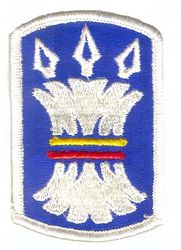 157th "Spartan" Infantry Brigade157th Infantry Brigade (United States)The 157th Infantry Brigade is an active/reserve component unit based at Camp Atterbury, Indinia. The unit is responsible for training selected United States Army Reserve and National Guard units. The unit was activated using the assets of the 5th Brigade, 87th Division...
157th "Spartan" Infantry Brigade157th Infantry Brigade (United States)The 157th Infantry Brigade is an active/reserve component unit based at Camp Atterbury, Indinia. The unit is responsible for training selected United States Army Reserve and National Guard units. The unit was activated using the assets of the 5th Brigade, 87th Division...
– Fort Jackson, South Carolina. Formerly the 87th Division's 5th Brigade.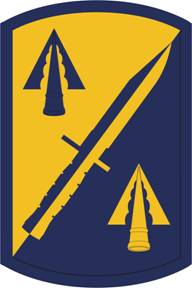 158th "Warrior" Infantry Brigade158th Infantry Brigade (United States)The 158th Infantry Brigade is an infantry brigade of the United States Army. It has subordiate battalions throughout Florida and Puerto Rico....
158th "Warrior" Infantry Brigade158th Infantry Brigade (United States)The 158th Infantry Brigade is an infantry brigade of the United States Army. It has subordiate battalions throughout Florida and Puerto Rico....
– Patrick Air Force Base, Florida. Formerly the 87th Division's 2nd Brigade. 174th "Patriot" Infantry Brigade174th Infantry Brigade (United States)The 174th Infantry Brigade is an infantry brigade of the United States Army based at Fort Drum, New York. A U.S. Army Reserve training unit, the brigade provides operational training readiness for units in the First Army....
174th "Patriot" Infantry Brigade174th Infantry Brigade (United States)The 174th Infantry Brigade is an infantry brigade of the United States Army based at Fort Drum, New York. A U.S. Army Reserve training unit, the brigade provides operational training readiness for units in the First Army....
– Fort Drum, New York. Formerly the 78th Division's 2nd Brigade.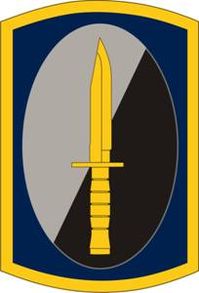 188th "Battle Ready" Infantry Brigade188th Infantry Brigade (United States)The 188th Infantry Brigade is an infantry brigade of the United States Army based at Fort Stewart, Georgia. It is a subordinate unit of the First United States Army, Division East....
188th "Battle Ready" Infantry Brigade188th Infantry Brigade (United States)The 188th Infantry Brigade is an infantry brigade of the United States Army based at Fort Stewart, Georgia. It is a subordinate unit of the First United States Army, Division East....
– Fort Stewart, Georgia. Formerly the 87th Division's 4th Brigade. 205th "Bayonet" Infantry Brigade205th Infantry Brigade (United States)The 205th Infantry Brigade, was first formed as part of the United States Army Reserve's 103rd Division. It was active from 1921 to 1942 and then from 1963 through 1994, and then reformed in 2006....
205th "Bayonet" Infantry Brigade205th Infantry Brigade (United States)The 205th Infantry Brigade, was first formed as part of the United States Army Reserve's 103rd Division. It was active from 1921 to 1942 and then from 1963 through 1994, and then reformed in 2006....
– Indianapolis, Indiana. Formerly the 85th Division's 3rd Brigade. 177th "Mudcats" Armored Brigade177th Armored Brigade (United States)The 177th Armored Brigade is an AC/RC unit based at Camp Shelby, Mississippi. The unit is responsible for training selected United States Army Reserve and National Guard units. The unit was formerly designated as 3rd Brigade, 87th Division...
177th "Mudcats" Armored Brigade177th Armored Brigade (United States)The 177th Armored Brigade is an AC/RC unit based at Camp Shelby, Mississippi. The unit is responsible for training selected United States Army Reserve and National Guard units. The unit was formerly designated as 3rd Brigade, 87th Division...
– Camp Shelby, Mississippi. Formerly the 87th Division's 3rd Brigade.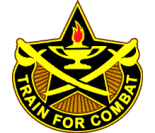 4th "Saber" Cavalry Brigade4th Cavalry Brigade (United States)The 4th Cavalry Brigade is an AC/RC unit based at Fort Knox, Kentucky. The unit is responsible for training selected United States Army Reserve & National Guard units that are based East of the Mississippi River. The brigade was originally formed as an element of the 2nd Cavalry Division but was...
4th "Saber" Cavalry Brigade4th Cavalry Brigade (United States)The 4th Cavalry Brigade is an AC/RC unit based at Fort Knox, Kentucky. The unit is responsible for training selected United States Army Reserve & National Guard units that are based East of the Mississippi River. The brigade was originally formed as an element of the 2nd Cavalry Division but was...
– Fort Knox, Kentucky. Formerly the 85th Division's 4th Brigade.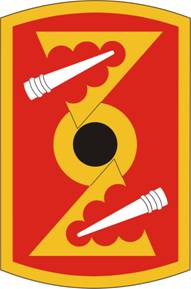 72nd "Warrior Eagle" Field Artillery Brigade72nd Field Artillery Brigade (United States)The 72nd Field Artillery Brigade is an AC/RC unit based at Fort George G. Meade, Maryland. The unit is responsible for training selected United States Army Reserve and National Guard units along the East coast. The unit was formerly designated as 5th Brigade, 78th Division...
72nd "Warrior Eagle" Field Artillery Brigade72nd Field Artillery Brigade (United States)The 72nd Field Artillery Brigade is an AC/RC unit based at Fort George G. Meade, Maryland. The unit is responsible for training selected United States Army Reserve and National Guard units along the East coast. The unit was formerly designated as 5th Brigade, 78th Division...
– Fort Meade, Maryland. Formerly the 78th Division's 5th Brigade.
First Army Division West
First Army Division West
The First Army Division West is a division of the First United States Army. With its new role, the First United States Army developed two subordinate multi-component headquarters – one division to support the western United States and the other to support the eastern United States. First Army...
– Fort Hood, Texas
-
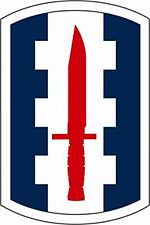 120th Infantry Brigade120th Infantry Brigade (United States)The 120th Infantry Brigade is an AC/RC unit based at Fort Hood, Texas.The unit falls under command of First Army, Division West and is responsible for training selected United States Army Reserve & National Guard units in Texas & the South-Western U.S....
120th Infantry Brigade120th Infantry Brigade (United States)The 120th Infantry Brigade is an AC/RC unit based at Fort Hood, Texas.The unit falls under command of First Army, Division West and is responsible for training selected United States Army Reserve & National Guard units in Texas & the South-Western U.S....
– Fort Hood, Texas. Formerly the 75th Division's 2nd Brigade. 166th Aviation Brigade166th Aviation Brigade (United States)The 166th Aviation Brigade is an aviation training brigade of the United States Army headquartered at Fort Hood, Texas. It is a subordinate unit of First Army - Division West...
166th Aviation Brigade166th Aviation Brigade (United States)The 166th Aviation Brigade is an aviation training brigade of the United States Army headquartered at Fort Hood, Texas. It is a subordinate unit of First Army - Division West...
– Fort Hood, Texas. Formerly the 75th Division's 3rd Brigade.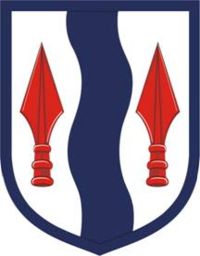 181st "Eagle" Infantry Brigade181st Infantry Brigade (United States)The 181st Infantry Brigade is an infantry brigade of the United States Army based at Fort McCoy, Wisconsin. As an Active Component/Reserve Component brigade, the unit serves primarily in a training role for other units of the US Armed forces. The brigade is subordinate to the First United States...
181st "Eagle" Infantry Brigade181st Infantry Brigade (United States)The 181st Infantry Brigade is an infantry brigade of the United States Army based at Fort McCoy, Wisconsin. As an Active Component/Reserve Component brigade, the unit serves primarily in a training role for other units of the US Armed forces. The brigade is subordinate to the First United States...
– Fort McCoy, Wisconsin. Formerly the 85th Division's 2nd Brigade.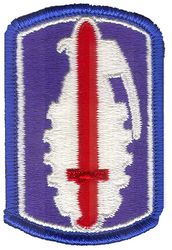 191st Infantry Brigade191st Infantry Brigade (United States)-Organization:The unit is composed of:*Headquarters & Headquarters Company, 191st Infantry Brigade*Several training battalionsThe 191st Infantry Brigade, was first formed as part of the United States Army Reserve's 96th Division.- Present :...
191st Infantry Brigade191st Infantry Brigade (United States)-Organization:The unit is composed of:*Headquarters & Headquarters Company, 191st Infantry Brigade*Several training battalionsThe 191st Infantry Brigade, was first formed as part of the United States Army Reserve's 96th Division.- Present :...
– Fort Lewis, Washington. Formerly the 91st Division's 4th Brigade. 402nd Field Artillery Brigade402nd Field Artillery Brigade (United States)The 402nd Field Artillery Brigade is an AC/RC/NG unit based at Travis Air Force Base, California. The unit is responsible for training selected United States Army Reserve & Army National Guard units along the West coast. The unit was formerly designated as 3rd Brigade, 91st Infantry Division, and...
402nd Field Artillery Brigade402nd Field Artillery Brigade (United States)The 402nd Field Artillery Brigade is an AC/RC/NG unit based at Travis Air Force Base, California. The unit is responsible for training selected United States Army Reserve & Army National Guard units along the West coast. The unit was formerly designated as 3rd Brigade, 91st Infantry Division, and...
– Fort Bliss, Texas. Formerly the 91st Division's 3rd Brigade. 479th Field Artillery Brigade479th Field Artillery Brigade (United States)-Lineage:*Constituted 11 March 1944 in the Army of the United States as the 656th Field Artillery Battalion*Activated 20 April 1944 at Camp Rucker, Alabama*Deployed via New York Port of Embarkation 30 November 1944*Arrived in England 8 December 1944...
479th Field Artillery Brigade479th Field Artillery Brigade (United States)-Lineage:*Constituted 11 March 1944 in the Army of the United States as the 656th Field Artillery Battalion*Activated 20 April 1944 at Camp Rucker, Alabama*Deployed via New York Port of Embarkation 30 November 1944*Arrived in England 8 December 1944...
– Fort Hood, Texas. Formerly the 75th Division's 4th Brigade.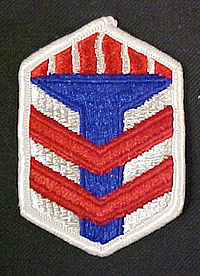 5th Armored Brigade5th Armored Brigade (United States)The 5th Armored Brigade is an AC/RC unit based at Fort Bliss, Texas. The unit is responsible for training selected United States Army Reserve & Army National Guard units west of the Mississippi River before they deploy to conduct combat operations overseas. The unit was formerly designated as 2nd...
5th Armored Brigade5th Armored Brigade (United States)The 5th Armored Brigade is an AC/RC unit based at Fort Bliss, Texas. The unit is responsible for training selected United States Army Reserve & Army National Guard units west of the Mississippi River before they deploy to conduct combat operations overseas. The unit was formerly designated as 2nd...
– Fort Bliss, Texas. Formerly the 91st Division's 2nd Brigade.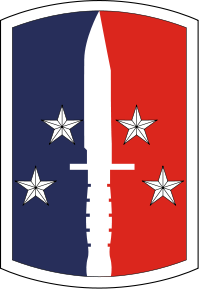 189th "Bayonet" Infantry Brigade189th Infantry Brigade (United States)The 189th Infantry Brigade is an Infantry brigade of the United States Army based at Joint Base Lewis-McChord, Washington. It is a training brigade subordinate to First Army....
189th "Bayonet" Infantry Brigade189th Infantry Brigade (United States)The 189th Infantry Brigade is an Infantry brigade of the United States Army based at Joint Base Lewis-McChord, Washington. It is a training brigade subordinate to First Army....
– Fort Bragg, North Carolina. Formerly the 78th Division's 4th Brigade.

